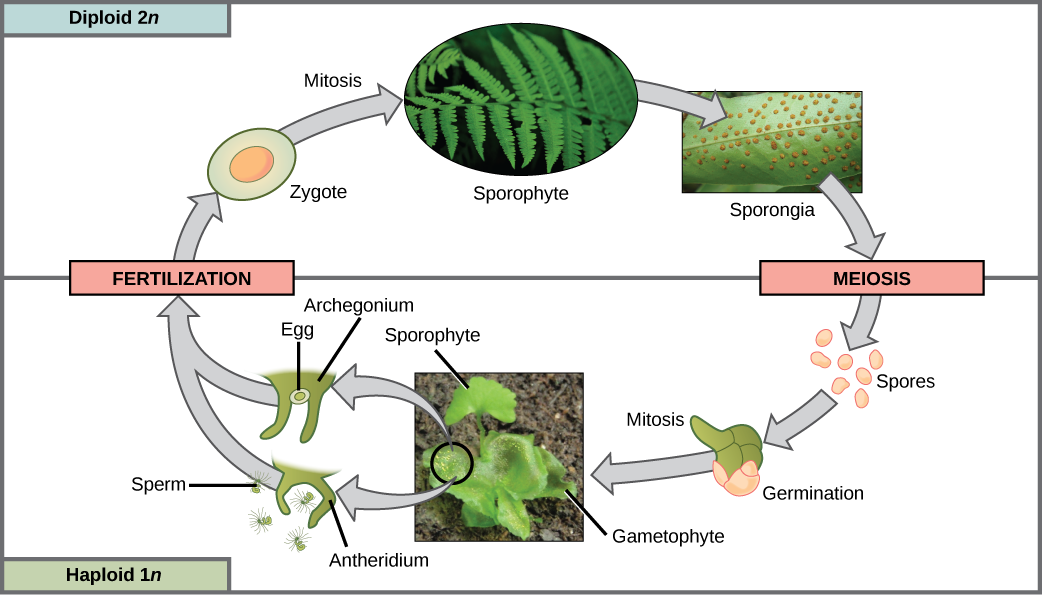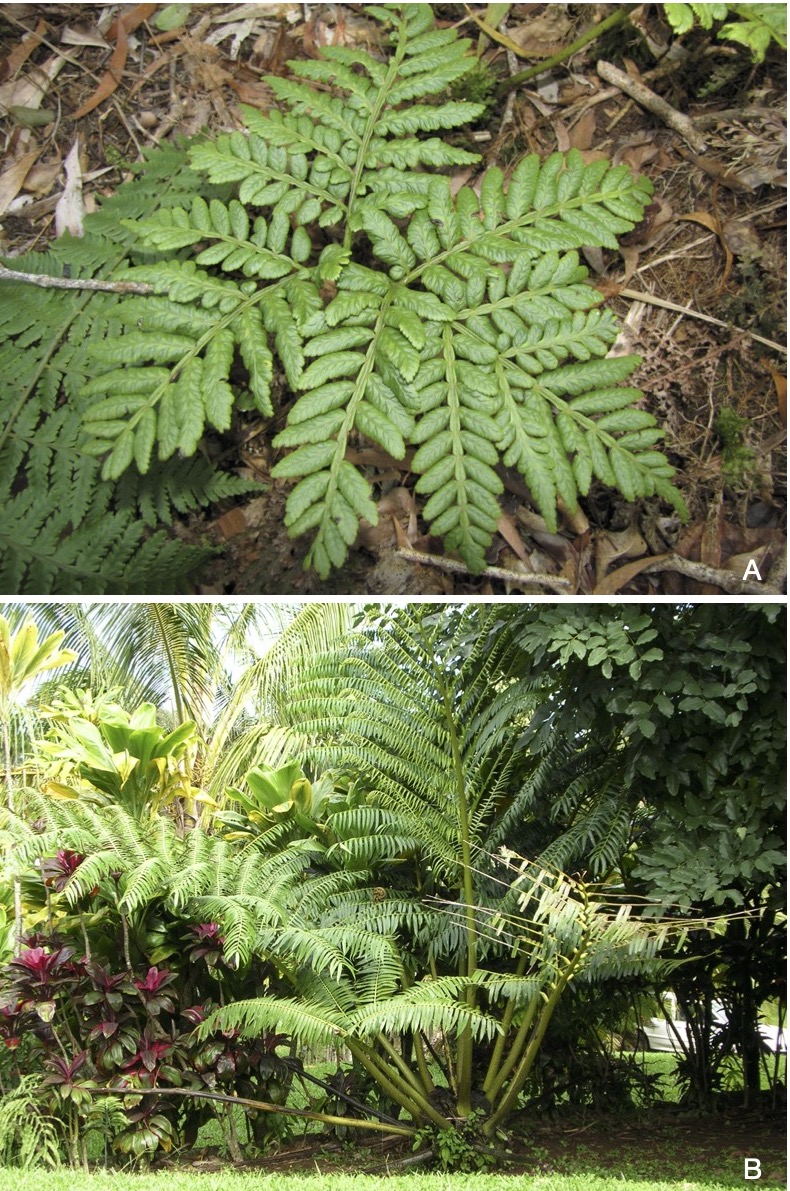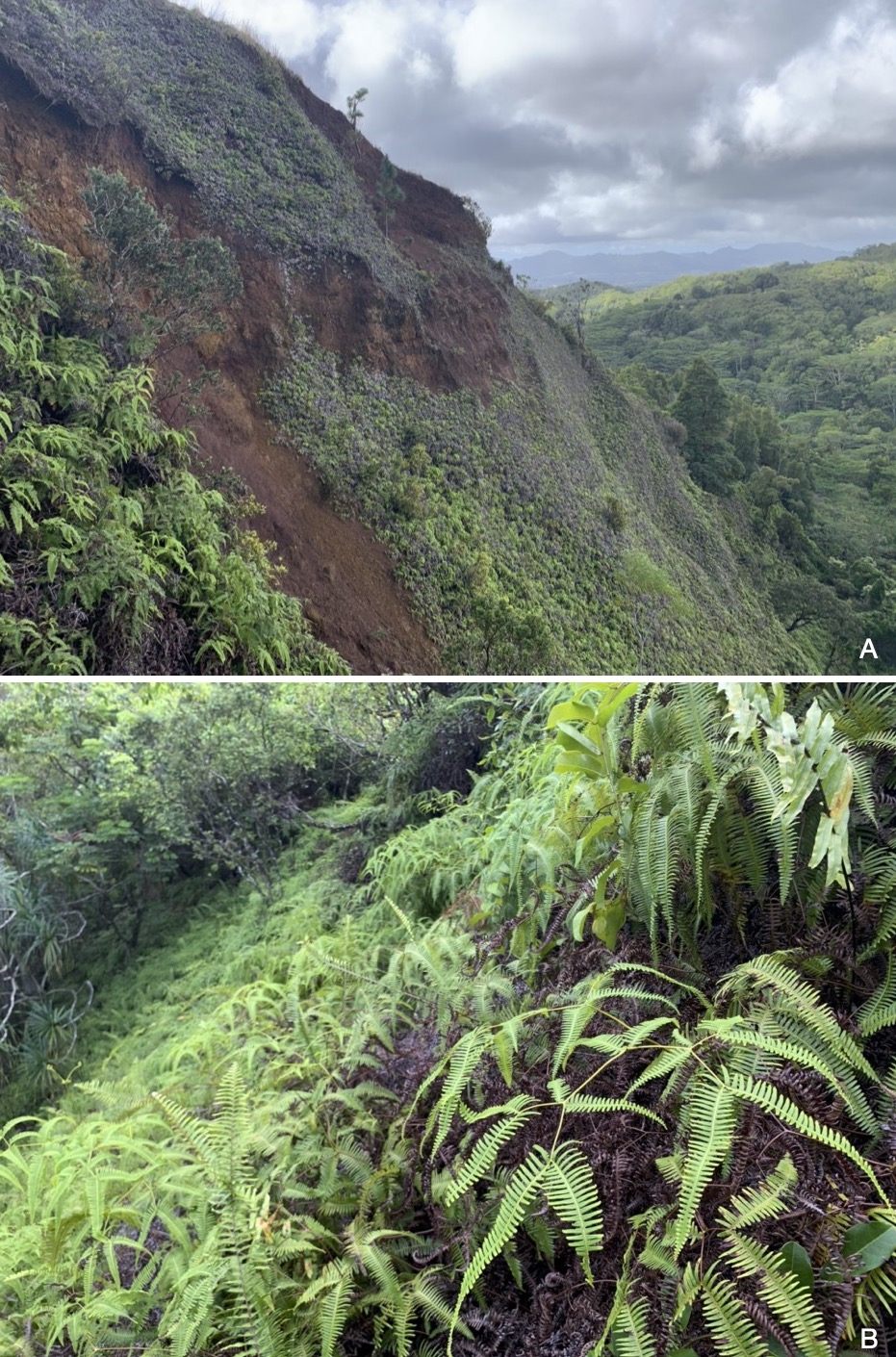7.3: Ferns
- Page ID
- 59244
There are about 10,560 species of living ferns worldwide (PPG I, 2016). Hawai‘i has approximately 188 species with 111 of them being endemic and 35 indigenous to the Hawaiian Islands. Additionally, 40 species of introduced ferns have become naturalized (Ranker et al., 2019). As with lycophytes, the sporophyte is the dominant stage in the fern's life cycle, and the gametophyte is a separate, free-living plant (Figure \(\PageIndex{1}\)).

Ferns are a common sight in most rural and urban areas and are widely used as indoor plants and in landscaping. In Hawaiian forests, remaining fern understories play critical roles. Fern leaves (megaphylls) are commonly referred to as fronds, which grow from an erect creeping rhizome (stem). They start as fiddleheads that uncurl. Fern sporophytes range in size from small, herbaceous plants of a few centimeters to tree-like plants more than 7 meters (25 feet) tall.
The spore-bearing structures in ferns are called sporangia (singular sporangium), which are clustered together in structures called sori (singular, sorus; Figure \(\PageIndex{1}\)). Sori are usually found on the underside of fertile fronds, and they can be rounded or linear, depending on the species. Sori shape and arrangement are used as key characteristics for the identification of different fern species.

Spores germinate into gametophytes (Figure \(\PageIndex{2}\)), which then produce gametes (sperm and egg) that, when combined, grow into sporophytes (what we typically see and think of as ʻferns’), completing the fern life cycle (Figure \(\PageIndex{3}\)). The gametophyte is smaller than a fingernail, and independent from the sporophyte (Figure \(\PageIndex{2}\)).
Ferns can grow in a variety of environments, but they are more common in wet ecosystems since they need water for sexual reproduction so that the sperm can swim to the egg on the gametophyte (Figure \(\PageIndex{3}\)).
Ferns can also reproduce asexually (vegetative reproduction) from the rhizome with new plants emerging from it. In the horticulture field, ferns are propagated by division (a plant can be split up into many).

Ferns are divided into four main groups (subclasses; PPG I, 2016): Equisetidae, Marattidae, Ophioglossidae, and Polypodiidae.
Equisetidae (horsetails)
Equisetales were once a diverse group of seedless vascular plants that were very common in the Carboniferous (300 million years ago) and have a rich fossil record. Today there is only one living genus, Equisetum, which is herbaceous, commonly reaching up to 1 meter in height (3 feet), but with some species able to reach 10 meters (32 feet). The name of this group is derived from the horsetail appearance that some branched species have. They are easy to recognize because of their green photosynthetic stems with vertical ridges (Figure \(\PageIndex{4}\)). Leaves are usually brown or black, triangular, small, and arranged as a whorl around the stem at the nodes (dark rings on Figure \(\PageIndex{4}\)).

Stems have silica on their cells, making these plants useful as polishing material. Some species have been used medicinally in Europe, the Americas, and Asia (especially in India) including as a diuretic and an anti-inflammatory medication (Carneiro et al., 2013). They are also used as food, eaten boiled or raw in different cultures, especially the tender young stems. There are no native species of this group in Hawai‘i. Several horsetail species were recently introduced to the islands to be used in gardening and landscaping, especially around ponds.
Marattiidae (mule’s foot)
This group has only one living family and 110 species worldwide (PPG I, 2016). It is the most ancient group of ferns. These species are known to have very large, vertical rhizomes. The leaf bases are swollen, with large fleshy stipules on either side (stipules of some species can be eaten). Muleʻs foot leaves can be very large, reaching up to 9 meters (30 feet) in length.
Hawai‘i has one native species, pala (Marattia douglasii). Another species, Angiopteris evecta, known as Madagascar’s tree fern or mule’s foot, has been introduced and is listed as an invasive species in Hawai‘i (Figure \(\PageIndex{5}\)).

Ophioglossidae (whisk ferns, adder’s-tongues)
Subclass Ophioglossidae has two orders: Psilotales (whisk ferns) and Ophioglossales (adder’s tongues). Whisk ferns are very easy to recognize since they look like a green whisk broom with triangular stems that branch dichotomously (in twos). They do not have roots. Their leaves are tiny, therefore the green stems perform most of the photosynthesis. Their sporangia (spore-bearing structures) are rounded, yellow, and can be seen suspended on the upper portions of the branches. Whisk ferns are found in all tropical environments around the world. In Hawai‘i, there are two indigenous species of whisk fern (Figure \(\PageIndex{6}\)). Moa nahele (Psilotum complanatum) has flat stems and moa (moa or Psilotum nudum) grows upright. These species are found in a wide variety of environments on all the main Hawaiian islands. Traditionally moa has been used for lei making as well as medicine; for example, as a laxative tea, and the spores were used as powder to prevent chafing (Krauss 1974).
.jpg?revision=1&size=bestfit&width=543&height=454)
Species of the Ophioglossales (adder's-tongue ferns) are often characterized by producing only one fleshy leaf at a time. Also, their gametophytes occur underground and they rely on mycorrhizal fungi for nutrition. Hawai‘i has four indigenous and one endemic species in the Ophioglossales. An example is puapua moa or old-world adder's-tongue (Ophioderma pendulum). Its sporangia are held within a spike that dangles from the middle of a leaf (Figure \(\PageIndex{7}\)).

Polypodiidae
This is the largest group of ferns with most species of ferns in Hawai‘i belonging to it. Species in this group are very important for the ecology of native ecosystems in Hawai‘i. They flourish in wet and mesic forests, in which they may become the dominant group covering the soil, as well as being present in the mid-canopy as epiphytic species (growing on trees without harming them). Some ferns are pioneers on recent lava flows, where they start to break down the rock into soil and prepare the way for subsequent plant colonization, an important step in the formation of plant communities. Ferns also colonize areas where landslides have occurred. For example, uluhe (Dicranopteris spp.) can be seen growing in steep areas where the soil has been exposed by landslides (Figure \(\PageIndex{8}\)). Uluhe species grow in thick mats, preventing invasive seeds from germinating and establishing, which helps the native species in the area by reducing competition.

In native forests, Polypodiidae species cover the soil surface (Figure \(\PageIndex{9}\)). Ferns break the force of the rain passing through the forest canopy so more water can get absorbed by the soil, and go into the aquifer, and erosion is reduced. Water runoff can be seen in areas where ferns and native forests are either disturbed or not present. After heavy rains, the ocean will turn brown due to all the sediment carried by the rain runoff from these mid-elevation disturbed areas.
The presence of introduced ungulates (pigs, deer, and mouflon sheep) has negatively impacted fern communities in Hawai‘i. Pigs dig around the soil to uncover worms and insects, disturbing the root system of ferns. Once the fern ground cover is removed, invasive species have a better chance to colonize the area. Fencing to keep pigs out has been a successful strategy in Hawai‘i that tremendously helps the conservation of native ecosystems. It gives fern communities a chance to recover, improving the chances that other native species can thrive.

In Hawai‘i there are several traditional uses for ferns in this group: lei making, fiber, and food. Some species of ferns were used medicinally (see Gutmanis, 1976). There are at least two species of ferns used for food. One species, hō‘i‘o or pohole (Diplazium sandwichianum), is endemic to the Hawaiian Islands and grows in mid-elevation mesic to wet forests. The most common fern used for food is Diplazium esculentum, an introduced fern often called hō‘i‘o or warabi in Hawaiʻi. Throughout the Pacific and Southeast Asia it is known as paca (Palmer, 2003). It grows very well in lowland wet areas. The newly emerged fiddleheads of both species are harvested before they uncurl (Figure \(\PageIndex{10}\)) and are eaten raw or steamed.

Another native Hawaiian fern, the hāpu‘u pulu (Cibotium glaucum) is a species of tree fern that produces hairs on its unfolding fronds, at the base of the stem (Figure \(\PageIndex{11}\)). These soft hairs were used as filling material, including for the stuffing of pillows. These ferns are also ornamentals, being transplanted into gardens for their beauty, and their stems are often used as a substrate for other plants such as orchids (Buck, 1982). Wild harvest of tree ferns has been of conservation concern in some parts of the globe including Hawai‘i.

In Hawai‘i, ferns are also commonly used in lei making (Figure \(\PageIndex{12}\)), with two native species often used: pala‘ā (Sphenomeris chinensis) and palapalai (Microlepia strigosa). Both of these ferns have special connections to Hawaiian culture and are seen as the physical representations (kinolau) of Laka, goddess of hula (palapalai), and Hi‘iaka (pala‘ā). The fronds of palapalai are also used to decorate hula altars (Ticktin et al., 2006). Both species are harvested from the wild and in some areas, there are protocols in place to maintain populations that have been negatively impacted by invasive species (Ticktin et al., 2006). The cultivation of pala‘ā in gardens can be challenging, however, palapalai is easy to grow and is used in landscapes in urban areas. If grown in the right conditions, this fern can produce many fronds that can then be harvested.


